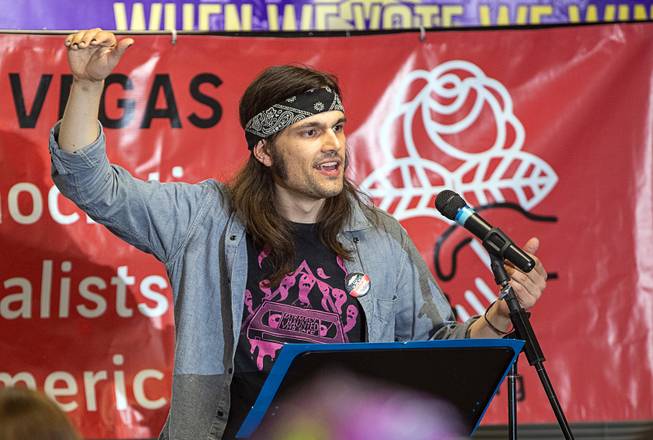
Tim Faust, author of “Health Justice Now: Single Payer and What Comes Next,” speaks during a book tour at SEIU offices Thursday, Sept. 19, 2019.
Friday, Oct. 11, 2019 | 2 a.m.
Tim Faust’s job sometimes leaves him feeling like a “library of human misery.” He tours the country to advocate for single-payer health care, meeting with people who share their struggles related to the structure of the American health care system. In Las Vegas in September, Faust spoke to the local chapter of Democratic Socialists of America on his book tour for Health Justice Now: Single Payer and What Comes Next. He called single-payer a tool that would help equalize access to health care. In the 2020 presidential election, health care expansion has been a dividing line between Democrats, with proposals ranging from a public option to full-on single-payer. Let’s break it down.
What is single-payer health care?
Single-payer health care is a term for a government-run system of health care financing. It has been commonly referred to during the 2020 presidential cycle as “Medicare for All.”
The plan for single-payer, at least as multiple politicians have proposed it, would leave doctors in the private market. Health insurance would be taken over by the government, similar to Canada. Doctors would not be employed by the government as they are in the United Kingdom’s model. Most plans for single-payer also include vision and dental care.
Of the 19 remaining Democratic candidates, Sens. Bernie Sanders, who wrote a bill to implement single-payer, and Elizabeth Warren support transferring all insurance responsibilities to the government.
Faust said people who may be wary of change should remember that the current insurance model changes constantly on an individual level—for example, when changing jobs.
“I can’t think of a more volatile structure in America right now than how contemporary health care works,” he said.
What is a public option?
A public option would allow people to choose to take part in a public health care system. Essentially, instead of signing up for Blue Cross Blue Shield, they could sign up for Medicare.
A public option is more popular among 2020 candidates than outright single-payer health care.
Narrowing down exactly what a public option would look like is more difficult, as Democratic candidates have outlined different proposals.
For example, South Bend, Indiana, Mayor Pete Buttigieg rolled out a “Medicare for All Who Want It” proposal that would allow Americans to buy into a public health care plan, which he argues will force private insurance to be competitive and “create a natural glide-path” to “Medicare for All.”
The plan of Sen. Kamala Harris, D-Calif., would immediately allow people to buy into Medicare while developing a 10-year phase-in system that would automatically insure newborns and the uninsured, and let those on other federal programs phase in.
However, this plan would allow private insurance plans to operate within the Medicare system with “stricter consumer protection standards.”
Faust is dismissive of a public option, and reiterated the need for a single-payer system. Anything less than that, he says, will leave cracks large enough for people to fall through.
“To demand [a] public option is to put private profit above actually building a meaningful and effective health care model,” he said.
Isn’t this essentially ‘Obamacare’?
No. While the Patient Protection and Affordable Care Act—President Barack Obama’s signature legislation—increased the amount of insured Americans, it stopped short of guaranteeing health care for everyone.
Instead, it allowed states to expand their Medicaid coverage and offered tax credits on some insurance plans. It also banned insurance providers from turning people down for pre-existing conditions.
After the ACA was enacted, the uninsured population dropped, but the Kaiser Family Foundation reports that, as of 2017, 27.4 million people remained uninsured.
Is single-payer popular?
The popularity of single-payer can be tricky to determine, but the numbers are generally promising for proponents.
The most recent polling from the Kaiser Family Foundation showed that 53% of respondents supported a single-payer program. Party affiliation, though, is a significant factor in determining support—69% of Republicans strongly oppose a single government health care plan, while 51% of Democrats strongly favor it and 26% of Democrats somewhat favor it.
Language and framing of the health care plan matter in determining favoritism as well. The terms “universal health coverage,” “Medicare for All” and “national health plan” have more positive reactions, while the terms “single-payer health insurance system” and “socialized medicine” have more negative reactions.
How much will it cost?
Single-payer isn’t cheap, but the cost will essentially come from a reshuffling of where people spend their money rather than new costs.
Sanders’ 2016 campaign estimated that over 10 years, Medicare for All would cost $13.8 trillion, a number that outside think tanks and studies have not backed up. For example, the Committee for a Responsible Federal Budget, a bipartisan think tank, has estimated Sanders’ proposal would cost $28 trillion over a decade, while the Urban Institute think tank estimated it would cost $32 trillion over that period.
According to the Centers for Medicare and Medicaid Services, Americans paid $3.5 trillion on health care services in 2017. If rates stayed there, that would be $35 trillion over a decade.
“Cost keeps skyrocketing, and nothing can bring it down,” Faust said. “Single-payer can. If we don’t, we’re going to be spending just south of $5 trillion in a decade. It’s not bad to spend money on health care, it’s bad to spend it on that much waste.”
However, under a single-payer system, out-of-pocket costs would be eliminated. According to Kaiser Family Foundation polling, most respondents did not understand that under a single-payer proposal, taxes would increase but costs at the point of service would be eliminated.
Essentially, Americans would pay more in taxes for the ability to pay nothing at the doctor’s office.
Physicians for a National Health Program—a single-payer advocacy group—said the program would be paid by a 7% payroll tax and a 2% income tax on individuals.
“The payroll tax would replace all other employer expenses for employees’ health care, which would be eliminated,” their statement reads. “The income tax would take the place of all current insurance premiums, co-pays, deductibles and other out-of-pocket payments.”
This story appeared in Las Vegas Weekly.

